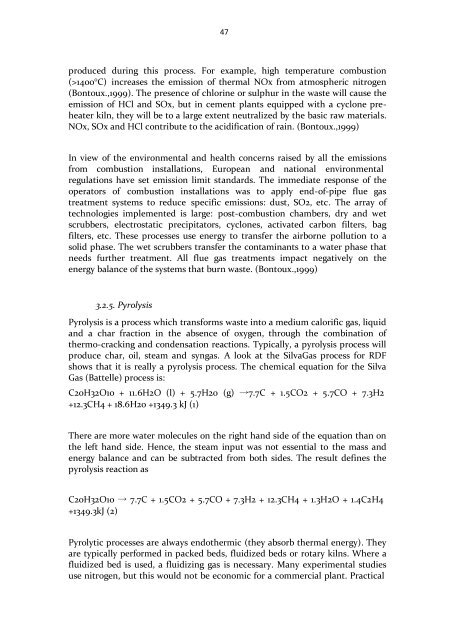(best examples and good practices) on household organic waste ...
(best examples and good practices) on household organic waste ...
(best examples and good practices) on household organic waste ...
Create successful ePaper yourself
Turn your PDF publications into a flip-book with our unique Google optimized e-Paper software.
47<br />
produced during this process. For example, high temperature combusti<strong>on</strong><br />
(>1400°C) increases the emissi<strong>on</strong> of thermal NOx from atmospheric nitrogen<br />
(B<strong>on</strong>toux.,1999). The presence of chlorine or sulphur in the <strong>waste</strong> will cause the<br />
emissi<strong>on</strong> of HCl <str<strong>on</strong>g>and</str<strong>on</strong>g> SOx, but in cement plants equipped with a cycl<strong>on</strong>e preheater<br />
kiln, they will be to a large extent neutralized by the basic raw materials.<br />
NOx, SOx <str<strong>on</strong>g>and</str<strong>on</strong>g> HCl c<strong>on</strong>tribute to the acidificati<strong>on</strong> of rain. (B<strong>on</strong>toux.,1999)<br />
In view of the envir<strong>on</strong>mental <str<strong>on</strong>g>and</str<strong>on</strong>g> health c<strong>on</strong>cerns raised by all the emissi<strong>on</strong>s<br />
from combusti<strong>on</strong> installati<strong>on</strong>s, European <str<strong>on</strong>g>and</str<strong>on</strong>g> nati<strong>on</strong>al envir<strong>on</strong>mental<br />
regulati<strong>on</strong>s have set emissi<strong>on</strong> limit st<str<strong>on</strong>g>and</str<strong>on</strong>g>ards. The immediate resp<strong>on</strong>se of the<br />
operators of combusti<strong>on</strong> installati<strong>on</strong>s was to apply end-of-pipe flue gas<br />
treatment systems to reduce specific emissi<strong>on</strong>s: dust, SO2, etc. The array of<br />
technologies implemented is large: post-combusti<strong>on</strong> chambers, dry <str<strong>on</strong>g>and</str<strong>on</strong>g> wet<br />
scrubbers, electrostatic precipitators, cycl<strong>on</strong>es, activated carb<strong>on</strong> filters, bag<br />
filters, etc. These processes use energy to transfer the airborne polluti<strong>on</strong> to a<br />
solid phase. The wet scrubbers transfer the c<strong>on</strong>taminants to a water phase that<br />
needs further treatment. All flue gas treatments impact negatively <strong>on</strong> the<br />
energy balance of the systems that burn <strong>waste</strong>. (B<strong>on</strong>toux.,1999)<br />
3.2.5. Pyrolysis<br />
Pyrolysis is a process which transforms <strong>waste</strong> into a medium calorific gas, liquid<br />
<str<strong>on</strong>g>and</str<strong>on</strong>g> a char fracti<strong>on</strong> in the absence of oxygen, through the combinati<strong>on</strong> of<br />
thermo-cracking <str<strong>on</strong>g>and</str<strong>on</strong>g> c<strong>on</strong>densati<strong>on</strong> reacti<strong>on</strong>s. Typically, a pyrolysis process will<br />
produce char, oil, steam <str<strong>on</strong>g>and</str<strong>on</strong>g> syngas. A look at the SilvaGas process for RDF<br />
shows that it is really a pyrolysis process. The chemical equati<strong>on</strong> for the Silva<br />
Gas (Battelle) process is:<br />
C20H32O10 + 11.6H2O (l) + 5.7H20 (g) →7.7C + 1.5CO2 + 5.7CO + 7.3H2<br />
+12.3CH4 + 18.6H20 +1349.3 kJ (1)<br />
There are more water molecules <strong>on</strong> the right h<str<strong>on</strong>g>and</str<strong>on</strong>g> side of the equati<strong>on</strong> than <strong>on</strong><br />
the left h<str<strong>on</strong>g>and</str<strong>on</strong>g> side. Hence, the steam input was not essential to the mass <str<strong>on</strong>g>and</str<strong>on</strong>g><br />
energy balance <str<strong>on</strong>g>and</str<strong>on</strong>g> can be subtracted from both sides. The result defines the<br />
pyrolysis reacti<strong>on</strong> as<br />
C20H32O10 → 7.7C + 1.5CO2 + 5.7CO + 7.3H2 + 12.3CH4 + 1.3H2O + 1.4C2H4<br />
+1349.3kJ (2)<br />
Pyrolytic processes are always endothermic (they absorb thermal energy). They<br />
are typically performed in packed beds, fluidized beds or rotary kilns. Where a<br />
fluidized bed is used, a fluidizing gas is necessary. Many experimental studies<br />
use nitrogen, but this would not be ec<strong>on</strong>omic for a commercial plant. Practical










